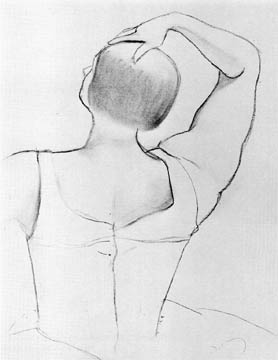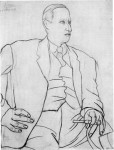
André Derain
French, 1880-1954
Ballerina with Raised Arm, 1925
charcoal on paper
24 × 19 1/2 in.
SBMA, Gift of Wright S. Ludington
1944.2.6

Portrait of Derain , 1919 by Pablo Picasso, Musee Picasso, Paris
COMMENTS
A dancer’s body is the object Derain studies in Ballerina with raised arm, produced around 1925. This charcoal drawing on paper illustrates well Derain’s evolution of style toward classicism, more specifically the change in his personal conception of line. Derain writes: “Cubism destroyed drawing by cutting to its root the hope for an unknown line."
For Derain, “a line is this path, this trail that elongates and misshapes if it is not exact and constantly more precise."2.
His exploration of the line, indeed his obsession for the model, is not fuelled as much by an idealistic neo-classicism, as by a diligent and disciplined daily practice in the pursuit of “an exact line that is outline, shape, movement and sensation all at the same time." The painter in his studio “sits, kneels, squats, elongates, bends, twists and scrutinises the object." 3.
In Ballerina with raised arm, the fluid and sinuous line that defines her, at times lighter, at other times darker, supports simultaneously the relaxation and the tension her body suggests. One can appreciate the gracious lift of her pose, as well as its heaviness. The carefully observed light caresses unevenly the shapes of the neck, back, shoulders, and arm of the ballerina and gives her an undeniable presence in form and volume.
The impressive, unconventional, almost provocative musculature of Derain’s Ballerina with raised arm, may be influenced by his increased interest in African art at the time. It may also come from his preoccupation with painting the pure and true essence of things, and from his lifelong fascination with what is eternal and non-temporal in painting: space, density, light and movement.
André Derain never sought to please. In half a century, he produced a significant body of work without denying his personal convictions, even though they were not consistent with the historical trend of Modern art. In his work, we can recognize a spirit of audacity and discipline. The diversity of his styles is viewed by some as strength, while others see it as weakness. Ultimately, it reveals Derain’s complex but conscious decision to reconcile western classical tradition with modernity in order to produce an art of all times.
Information taken from research paper on Three Nudes in Front of a Fireplace, also by André Derain
Prepared for the Santa Barbara Museum of Art Docent Council
by Chantal Gariepy, January 7, 2006.
